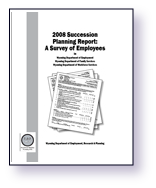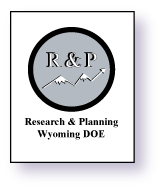Selected Findings
Demographics
• Employees in the Department of Family Services (DFS), the Department of Employment (DOE), and the Department of Workforce Services (DWS) are somewhat older than those in state government as a whole.
• DFS, DOE, and DWS employ a much greater proportion of female employees than male employees compared to the whole of state government.
Selected Cross-Tabulations and Chi-Square Analysis
• Chi-square analysis can be used to identify agencies with statistically significant different answers compared to the other agencies. For example: Sometimes respondents in one agency answered a question differently than those in the other agencies, such as with the statement, “The mission/purpose of my department makes me feel my job is important,” to which a greater proportion of DWS employees answered negatively compared to DOE or DFS.
• Some satisfaction measures had similar responses in each agency, such as the statement, “Overall, I am satisfied with my department as a place to work.”
Factor and Logistic Analysis
• Factor analysis reduced the number of variables used in the modeling process.
• Logistic regression modeling indicated which respondents might be more likely to leave their employer based on the questionnaire and their demographic characteristics.
• The three factors revealed in the answers to questions 1- 29 included social cohesion, barriers to success, and barriers to upward mobility.
• Worker age and perceptions of external pay equity appeared to influence employees’ stated intent to leave their jobs.
• Respondents indicated that the risk of stated intent to leave increased if they thought they could receive more respect from management and have more personal interest in their work with another employer.
Turnover
• DOE appears to be a very stable agency in terms of both size and turnover activity. Hire and exit rates were both well below those for the entire executive branch.
• DWS appears to be becoming a smaller but more stable agency.
• DFS grew but had less employment stability over time.
• All three state agencies appear to be strongly tied to Wyoming’s labor market hiring from and losing exiters to private sector employers in Wyoming. Other agencies within state government and local government entities also form a substantial portion of the market for hires and exits among the three agencies under study.
Occupations of Concern
• Management positions may be a concern for all agencies as well as accountants and auditors in both DFS and DOE. Possible programs aimed at providing managerial training for first-line or mid-level supervisors may be warranted.
• There appears to be a concern in regard to fundamental positions within each of the departments. Eligibility interviewers in DOE, social workers in DFS, and employment specialists in DWS may be of concern for turnover.

